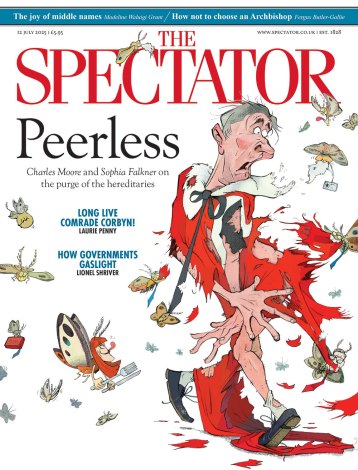
Chaplin’s Girl, by Miranda Seymour
Love Child, by Allegra Huston
Virginia Cherrill was an exceptionally pretty young woman when she turned up in Los Angeles in the late 1920s, looking for fun and adventure. Here Charlie Chap- lin spotted her, in the front row at a boxing match, and invited her to star in his forthcoming movie, City Lights. Still considered among his greatest films, it gave Cherrill the chance to captivate audiences with her portrayal of the blind flower girl. It wasn’t long before she met the young Cary Grant, who followed her to England, begging her to marry him. ‘Endearing, gorgeous and elegant, the Grants made a magnificent couple’, writes Miranda Seymour.
Grant was her second husband, but not her last. Cherrill wasn’t much of an actress and her career dwindled: she preferred travel and a life of leisure. She romanced the Maharaja of Jaipur, married the Earl of Jersey and only settled down after her fourth marriage, to a dashing but impoverished Polish airman. ‘She led a life that was dictated by the strokes of good fortune that befell a beautiful woman possessed of unique charm’.
As these quotes from the book make clear, Miranda Seymour thoroughly approves of her subject. The reader may not altogether agree with this rose-tinted account. It is clear that Virginia Cherrill was good-natured, nice looking and unpretentious; that she loved animals and jokes; was a kind and loyal friend. Students of Charlie Chaplin’s life will recall that the famous scene from City Lights, where the tramp first encounters the flower girl, required 342 takes. Seymour puts this down to Chaplin’s obsessive nature and considers it churlish of Chaplin to have sacked Cherrill for such minor misdemeanours as taking long lunchbreaks and not appearing on set (he later reinstated her). To the casual reader, though, Cherrill comes across as unprofessional, at best.
Divorcing Cary Grant after ten months of marriage (there were no children), Cherrill petitions for $1,000 a month. In 1934! Even today’s politicians might blench at such flagrant greed. Seymour calls it ‘unsporting’ of Grant to have suggested a lower amount, but I felt sorry for the man. ‘I admire Virginia Cherrill for taking charge of destiny [sic] and choosing love above circumstance’, Seymour concludes. The whirl of romance makes Virginia Cherrill’s story very jolly, but it’s grit that makes a pearl.
At first glance, Love Child looks like another starry Hollywood autobiography. Its author, Allegra Huston, is the daughter of director John Huston and sister to movie star Anjelica and actor Danny. There are photographs of her as a child in a swimming-pool with Jack Nicholson and on the beach in Malibu. She lives in Georgian splendour in Ireland, then in various beach or canyon houses in America or Mexico; she is driven about in a blue Cadillac or a Rolls Royce.
But this is far from a glamour-memoir. From the first page it is evident that Allegra Huston is a wonderful writer and unblinkingly honest, about herself and others:
My nomadic life, with its high-drama storyline and eccentric cast of characters, made me feel interesting and unusual — but also somehow fake, as if I hadn’t done anything to earn my special status. I felt, in myself, bog-ordinary.
This watchful, intelligent, modest girl lives a life that is anything but ordinary. After the early death of her mother, she is whisked off to Ireland, where John Huston’s sporadic visits are accorded the pomp of royalty. She is carted from pillar to post, first to live with her maternal grandparents, then with a discarded wife of John Huston’s, then with this step-mother’s own parents. She describes a bridge party here:
The ladies all had perfect lipstick and motionless hair, and they didn’t talk much except to bid and score. Their painted nails clicked on the cards; the ice clicked in their glasses; the glasses clicked on the laminated coasters.
It sounds a ghastly place to be brought up in. Soon she is taken in by Anjelica Huston, first under Jack Nicholson’s roof, then to Ryan O’Neal’s house, with its plate-glass windows and giant beds. It’s never a good sign when a man always eats the same food: Ryan O’Neal has tinned tomato soup and a foul temper (Lord Lucan ate lamb chops for lunch every day).
Only at 12 does she learn that her biological father is in fact the historian and writer John Julius Norwich. Lucky him. His daughter is beautiful, clever and independent. She seems blessed, too, with a complete absence of rancour towards all the grown-ups who gave her such an unsettled childhood. This is a remarkable book, one that will interest a much wider readership than the star-struck or the gossip-hungry. Anyone who reads it will hope that Allegra Huston has more books in her.





Comments